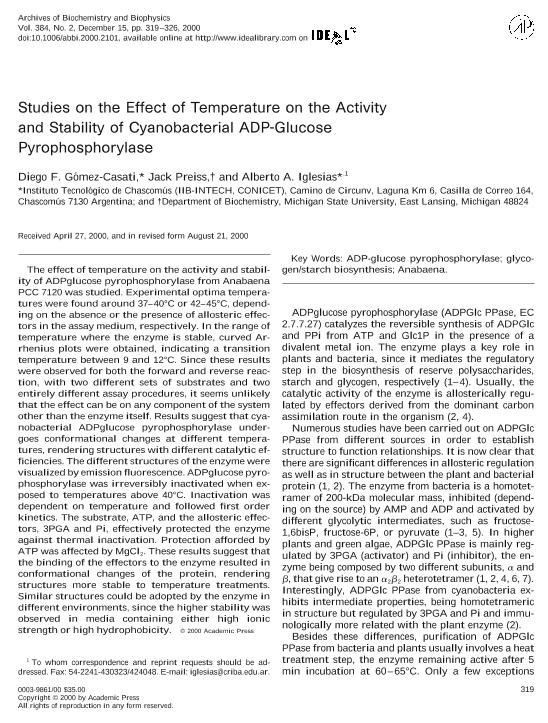Mostrar el registro sencillo del ítem
dc.contributor.author
Gomez Casati, Diego Fabian

dc.contributor.author
Preiss, Jack
dc.contributor.author
Iglesias, Alberto Alvaro

dc.date.available
2019-10-11T11:54:58Z
dc.date.issued
2000-12
dc.identifier.citation
Gomez Casati, Diego Fabian; Preiss, Jack; Iglesias, Alberto Alvaro; Studies on the effect of temperature on the activity and stability of cyanobacterial ADP-glucose pyrophosphorylase; Elsevier Science Inc; Archives of Biochemistry and Biophysics; 384; 2; 12-2000; 319-326
dc.identifier.issn
0003-9861
dc.identifier.uri
http://hdl.handle.net/11336/85661
dc.description.abstract
The effect of temperature on the activity and stability of ADPglucose pyrophosphorylase from Anabaena PCC 7120 was studied. Experimental optima temperatures were found around 37-40°C or 42-45°C, depending on the absence or the presence of allosteric effectors in the assay medium, respectively. In the range of temperature where the enzyme is stable, curved Arrhenius plots were obtained, indicating a transition temperature between 9 and 12°C. Since these results were observed for both the forward and reverse reaction, with two different sets of substrates and two entirely different assay procedures, it seems unlikely that the effect can be on any component of the system other than the enzyme itself. Results suggest that cyanobacterial ADPglucose pyrophosphorylase undergoes conformational changes at different temperatures, rendering structures with different catalytic efficiencies. The different structures of the enzyme were visualized by emission fluorescence. ADPglucose pyrophosphorylase was irreversibly inactivated when exposed to temperatures above 40°C. Inactivation was dependent on temperature and followed first order kinetics. The substrate, ATP, and the allosteric effectors, 3PGA and Pi, effectively protected the enzyme against thermal inactivation. Protection afforded by ATP was affected by MgCl2. These results suggest that the binding of the effectors to the enzyme resulted in conformational changes of the protein, rendering structures more stable to temperature treatments. Similar structures could be adopted by the enzyme in different environments, since the higher stability was observed in media containing either high ionic strength or high hydrophobicity.
dc.format
application/pdf
dc.language.iso
eng
dc.publisher
Elsevier Science Inc

dc.rights
info:eu-repo/semantics/openAccess
dc.rights.uri
https://creativecommons.org/licenses/by-nc-sa/2.5/ar/
dc.subject
ADP-GLUCOSE PYROPHOSPHORYLASE
dc.subject
ANABAENA
dc.subject
GLYCOGEN/STARCH BIOSYNTHESIS
dc.subject.classification
Bioquímica y Biología Molecular

dc.subject.classification
Ciencias Biológicas

dc.subject.classification
CIENCIAS NATURALES Y EXACTAS

dc.title
Studies on the effect of temperature on the activity and stability of cyanobacterial ADP-glucose pyrophosphorylase
dc.type
info:eu-repo/semantics/article
dc.type
info:ar-repo/semantics/artículo
dc.type
info:eu-repo/semantics/publishedVersion
dc.date.updated
2019-10-10T19:33:44Z
dc.journal.volume
384
dc.journal.number
2
dc.journal.pagination
319-326
dc.journal.pais
Estados Unidos

dc.description.fil
Fil: Gomez Casati, Diego Fabian. Consejo Nacional de Investigaciones Científicas y Técnicas. Centro Científico Tecnológico Conicet - La Plata. Instituto de Investigaciones Biotecnológicas. Universidad Nacional de San Martín. Instituto de Investigaciones Biotecnológicas; Argentina
dc.description.fil
Fil: Preiss, Jack. Michigan State University; Estados Unidos
dc.description.fil
Fil: Iglesias, Alberto Alvaro. Consejo Nacional de Investigaciones Científicas y Técnicas. Centro Científico Tecnológico Conicet - Santa Fe. Instituto de Agrobiotecnología del Litoral. Universidad Nacional del Litoral. Instituto de Agrobiotecnología del Litoral; Argentina
dc.journal.title
Archives of Biochemistry and Biophysics

dc.relation.alternativeid
info:eu-repo/semantics/altIdentifier/doi/http://dx.doi.org/10.1006/abbi.2000.2101
Archivos asociados
